Diamond Information
Commonly referred to as the 4 “Cs” cut, color, clarity and cost diamond consumers are armed with little else in terms of knowledge and education for the purchase of their diamond. Although good this information fails to be comprehensive leaving the consumer falsely confident and vulnerable. In addition to needing more information consumers are unaware that not every diamond seller or laboratory uses a standard scale such as the Gemological Institute of America’s scales for grading diamonds. Charts that follow display GIA’s standard scale and basic diamond information.
CUT
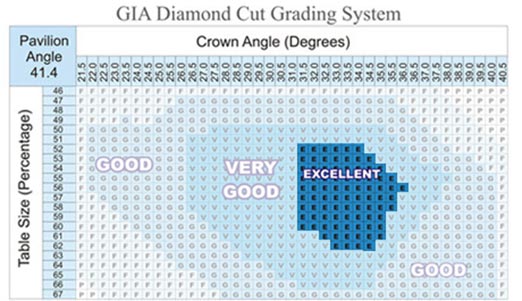

COLOR
In general I recommend to my clients that once they have set a clarity grade of SI1 or higher they put money into color. The human eye is unable to detect the microscopic difference in eye-clean diamonds as their clarity grades improve(GIA SI2 to F). It however easily can distinguish between a faint yellow K,L grade diamond and a colorless FG diamond.
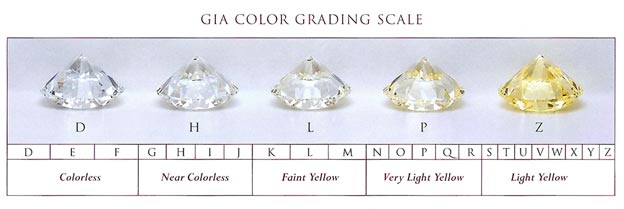
CLARITY
Diamonds that are visibly free of inclusions have a GIA clarity grade of SI2 (slightly included 2) or higher and those that internally have no inclusions even with use of magnification are considered internally flawless with a grade of IF. If the diamond’s exterior is without flaws the diamond is then internally and externally flawless with a grade of F. GIA clarity grades go down from SI2 to I1 and there is no SI3 which is a grade used by EGL (European Gemological Laboratory) with relatively poor consistency of use amongst its varying U.S and international sites.

COST
The overall trend for diamond prices is escalation. The amount of increase is determined by the economics of supply and demand. The Rapaport Index (subscribe to site http://www.diamonds.net/Prices/ or phone app or search online) provides a current indication of prices and notes how price fluctuates based on shape and size. Some shapes command higher prices and often are those in highest demand, the fancy shapes and carefully matched pairs . As the size of the diamond increases price increases but does so exponentially. Simply stated, a two carat diamond would not be equal to the price of 2 one carat diamonds but more likely 4 to 5.
GEMOLOGICAL LABORATORIES & REPORTS
A consumer may learn from one source that SI2 (slightly included 2) is a clarity grade given for a diamond that is eye-clean (no visible imperfections) in accordance to GIA standards but other sources present diamonds categorized as “SI2” that are visibility included. One lab will indicate a color grade of H while another D for the same diamond. For this reason it is highly recommended that consumers purchase a diamond that is certified by a recommended laboratory. Certification is only of value if provided by a reliable, valid and standardized laboratory.
World renowned gemological laboratories with quality, comprehensive services and state of the art equipment, methodology and standards are the Gemological Institute of America (GIA), the Institute of Gemology in Belgium-Antwerp (HRD) and the International Gemology Laboratory ( IGI). Their laboratory services include diamond and gemstone identification, origin and treatment or enhancement disclosure. A sample report from each is provided for reference in the information that follows.
Other noteworthy and recommended world-wide laboratories are listed below. Color Symphony uses GIA or AGL to certify stones purchased without certification. Previously the American Gem Trade Association lab was used but it closed in July, 2009 due to economic constraints. Many of the stones we buy from international dealers are already certified and most frequently come with assessments and reports from AIGS or GIT.
- The American Gemological Laboratory (AGL)
- American Gem Society (AGS)
- The Swiss Gemological Laboratory (SSEF)
- Gemological Association of All Japan (GAAJ)
- Gueblin Gemological Laboratory
- Asian Institute of Gemological Sciences (AIGS)
- Gemological Institute of Thailand (GIT)
The GIA (Gemological Institute of America) has two locations nationally, N.Y.C and Carlsbad, and an additional 14 international locations. This is the most commonly used laboratory for diamonds in the USA. http://www.gia.edu/

HRD (Institute of Gemology in Belgium in Antwerp)
The Hoge Raad voor Diamant (HRD), translats to ‘Diamond High Council’, was established in 1973. This highly acclaimed gemology lab monitors the import and export of more than half of the world’s loose diamonds and 80% of rough diamonds. HRD denotes precision, integrity and experience. http://www.hrd.be/en/home.aspx

IGI (INTERNATIONAL GEMOLOGICAL INSTITUTE) headquartered in Antwerp Belgium has sites world-wide including N.Y.C. and Los Angeles in the USA. http://www.igi-usa.com/igi_about.htm
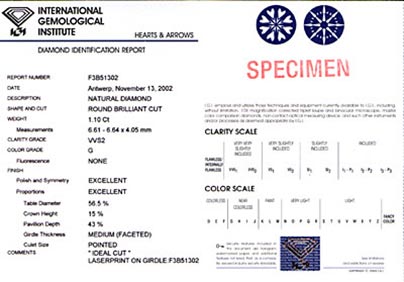
OTHER DIAMOND CHARACTERISTICS/INFORMATION
Fluorescence

The image above shows the same diamonds exposed to UV and natural light. This photograph and the information that follows is courtesy of GIA. “Fluorescence is the visible light some diamonds emit when they are exposed to invisible ultraviolet (UV) rays. On a GIA diamond grading report, fluorescence refers to the strength, or intensity, of the diamond’s reaction to long-wave UV, which is an essential component to daylight. The light emitted lasts as long as the diamond is exposed to the ultraviolet source.
Of the diamonds submitted to GIA over the past decade, approximately 25% to 35% exhibit some degree of fluorescence. However, only 10% of those show strengths of fluorescence that may impact appearance (i.e., strengths noted on laboratory reports as medium, strong or very strong). In more than 95% of the diamonds that exhibit fluorescence, the color seen is blue. In rare instances, the reaction is yellow, white or another color.
GIA studies show that, for the overwhelming majority of diamond, the strength of fluorescence has no widely noticeable effect on appearance. In many instances, observers prefer the appearance of diamonds that have medium to strong fluorescence. In rare cases, some diamonds with extremely strong fluorescence may appear hazy or oily: fewer than 0.2% of the fluorescent diamonds submitted to GIA exhibit this effect. A diamond with fluoresces has the same integrity as one with none.”
Shapes
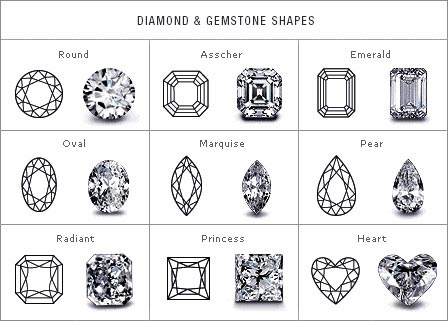
Diagram and Terminology
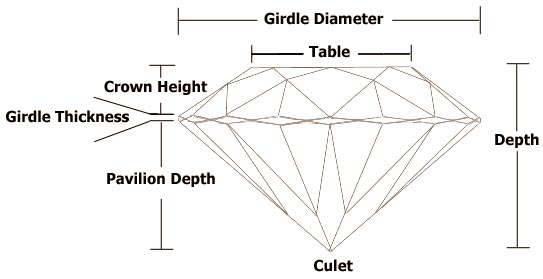
Recommended Resources
- Each of the gemological laboratories recommended have excellent information and education for the diamond and colored stone consumer.
- Diamond Ring Buying Guide: How to Evaluate, Identify, and Select Diamonds & Diamond Jewelry by Renee Newman (This is an excellent comprehensive and user-friendly book that I highly recommend.)
